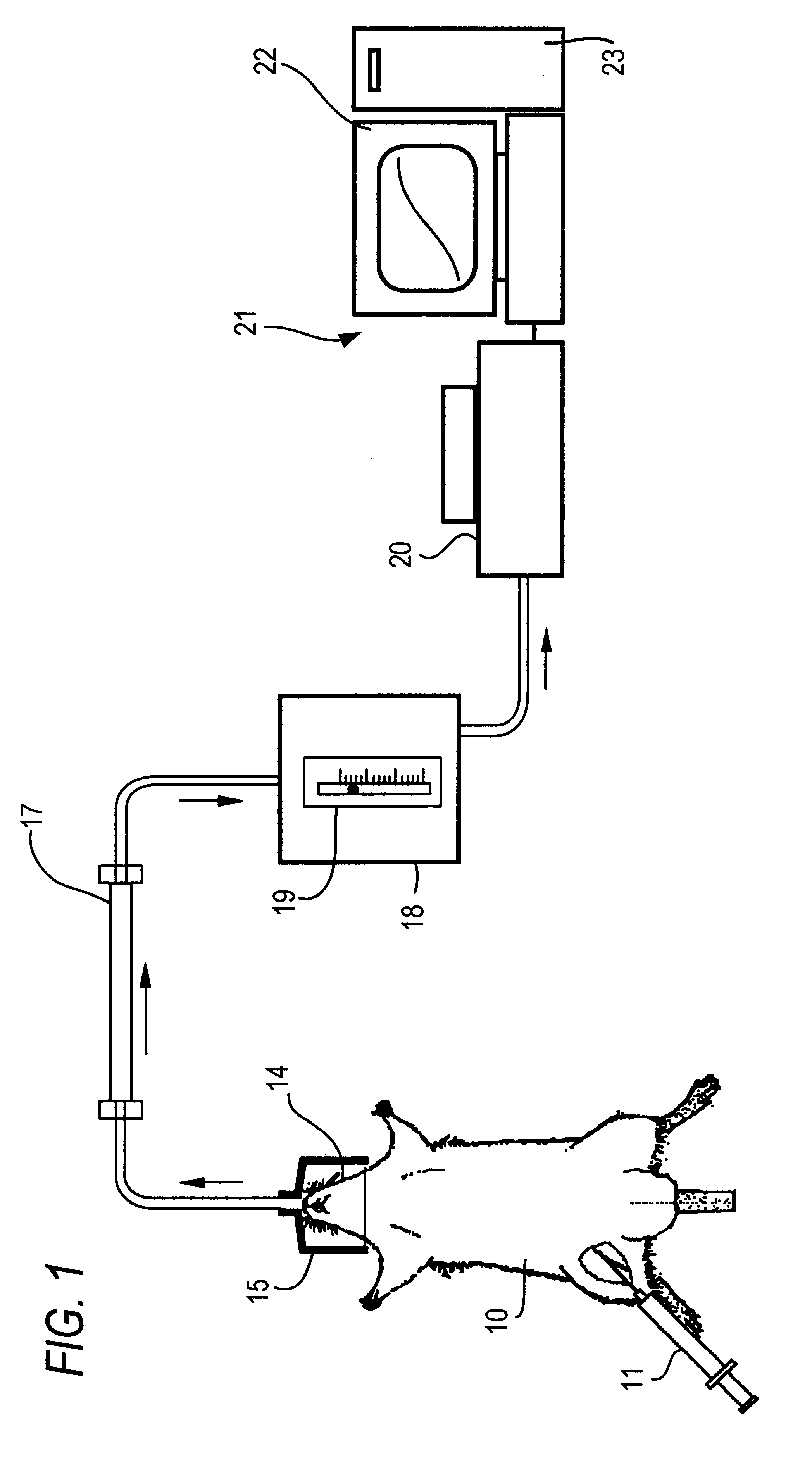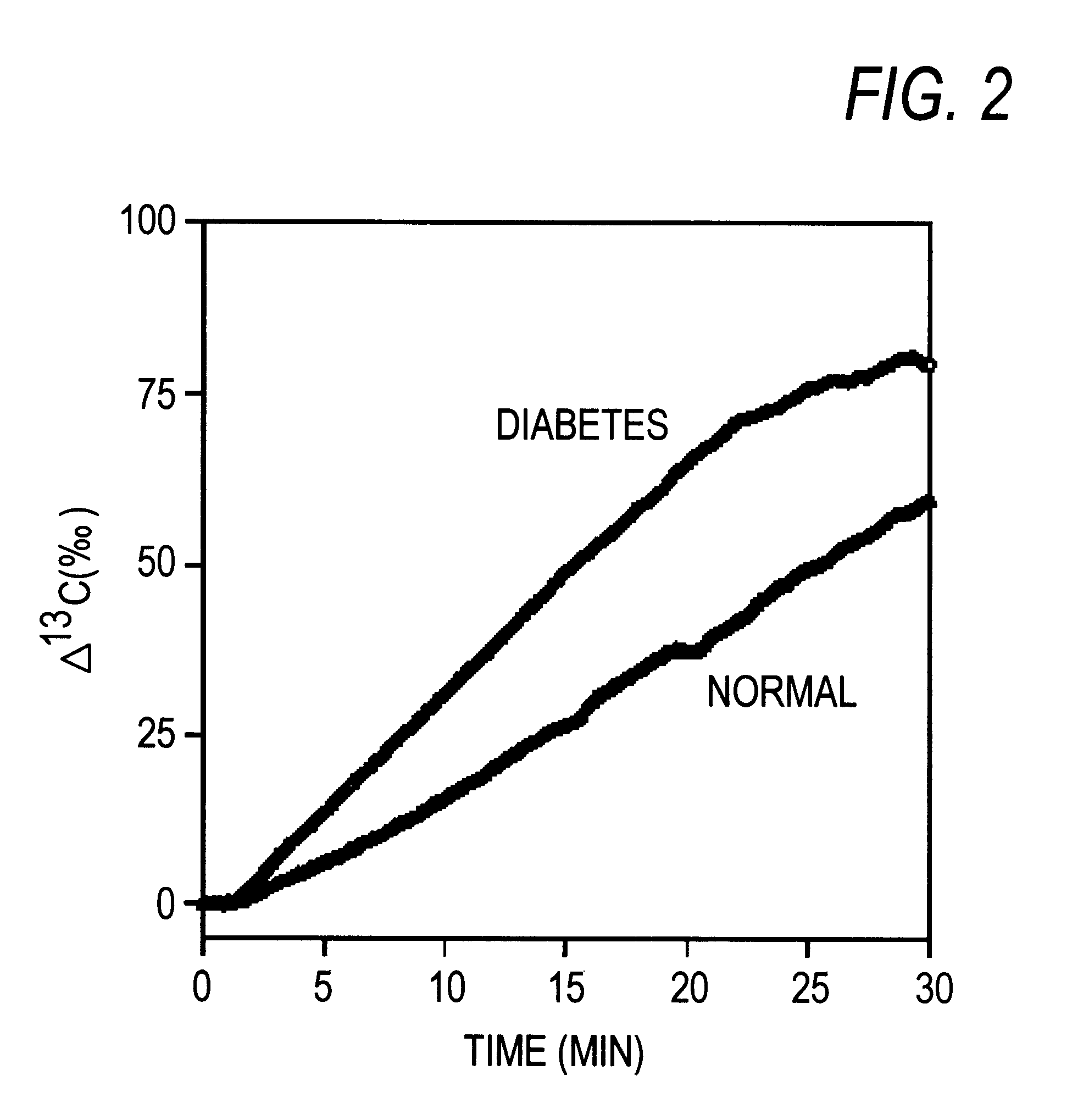Diagnostic agent for diabetes
a diabetes and diagnostic agent technology, applied in the direction of metabolism disorder, drug composition, therapy, etc., can solve the problems of imposing a heavy physical burden on a subject, giving negative results to patients with light diabetes, and 80% or more patients are missed, so as to achieve safe use and avoid side effects.
- Summary
- Abstract
- Description
- Claims
- Application Information
AI Technical Summary
Benefits of technology
Problems solved by technology
Method used
Image
Examples
example 1
Method of Breath Test
(1) Preparation of Rats with Light Diabetes
As test animals, male Sprague-Dawley strain (SD) neonatal rats were purchased from Nippon Charles River K. K. together with their lactating rats. They were bred at 23.+-.2.degree. C. under 55.+-.10% humidity before use.
Insulin secretion-deficient type diabetes was generated by administering streptozotocin (STZ) to neonatal rats ("Saibokogaku (Cell Engineering)", Extra Issue, medical Experiment Manual Series, Strategy for Study of Diabetes, edited by Susumu Seino and Yoshikazu Oka, published by Shujunsha Co., Japan). STZ was subcutaneously administered to 2-day-old rats at a dose of 90 mg / kg. The STZ had been dissolved in a citrate buffer (pH 4.5) and was administered within 5 min after the dissolution. Two days after the administration, blood was collected by cardiac puncture, and the casual blood sugar level of each rat was measured with Terumo Mediace (blood sugar measurement set). Those rats showing a casual blood su...
example 2
(EXAMPLE 2
1-.sup.13 C-Galactose Breath Test
1-.sup.13 C-galactose (purchased from ICON) dissolved in physiological saline was administered to normal rats (9-week-old; fasting blood sugar level 74.8.+-.5.1 mg / dl; n=4) and diabetic rats (9-week-old; casual blood sugar level 423.3.+-.87.5 mg / dl; fasting blood sugar level 94.+-.118.5 mg / dl; n=4) from the femoral vein at a dose of 100 mg / kg. Then, degrees of increase of .sup.13 C levels in exhaled CO.sub.2 (.DELTA..sup.13 C (.Salinity.)) were measured according to the method described in Example 1.
.DELTA..sup.13 C values (.Salinity.) continued increasing up to 30 min after the administration of 1-.sup.13 C-galactose in both the normal and the diabetic rats (FIG. 2).
The .DELTA..sup.13 C value (.Salinity.) at 20 min after the administration was 64.90.+-.5.75.Salinity. in the diabetic rats, while the corresponding value was 37.31.+-.3.37.Salinity. in the normal rats. Thus, the value in the diabetic rats was very significantly (p<0.01 (ANOVA ...
example 3
2-.sup.13 C-Galactose Breath Test
2-.sup.13 C-galactose (purchased from ICON) dissolved in physiological saline was administered to normal rats (9-week-old; fasting blood sugar level 63.8.+-.13.4 mg / dl; n=4) and diabetic rats (9-week-old; casual blood sugar level 371.5.+-.63.4 mg / dl; fasting blood sugar level 86.5.+-.22.6 mg / dl; n=4) from the femoral vein at a dose of 100 mg / kg. Then, degrees of increase of .sup.13 C levels in exhaled CO.sub.2 (.DELTA..sup.13 C (.Salinity.)) were measured according to the method described in Example 1.
.DELTA..sup.13 C values (.Salinity.) continued increasing up to 20 min after the administration of 2-.sup.13 C-galactose in both the normal and the diabetic rats (FIG. 3).
The .DELTA..sup.13 C value (.Salinity.) at 20 min after the administration was 29.68.+-.8.55.Salinity. in the diabetic rats, while the corresponding value was 15.00.+-.1.63.Salinity. in the normal rats. Thus, the value in the diabetic rats was significantly (p<0.05 (ANOVA with Fischer ...
PUM
 Login to View More
Login to View More Abstract
Description
Claims
Application Information
 Login to View More
Login to View More - R&D
- Intellectual Property
- Life Sciences
- Materials
- Tech Scout
- Unparalleled Data Quality
- Higher Quality Content
- 60% Fewer Hallucinations
Browse by: Latest US Patents, China's latest patents, Technical Efficacy Thesaurus, Application Domain, Technology Topic, Popular Technical Reports.
© 2025 PatSnap. All rights reserved.Legal|Privacy policy|Modern Slavery Act Transparency Statement|Sitemap|About US| Contact US: help@patsnap.com



